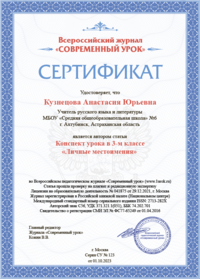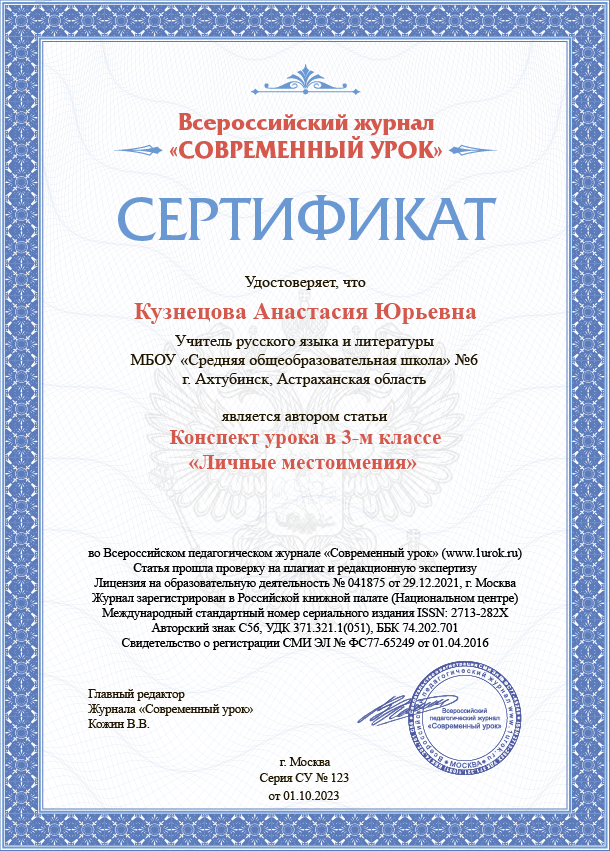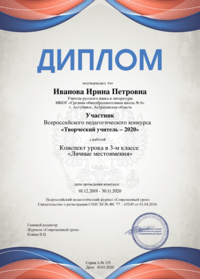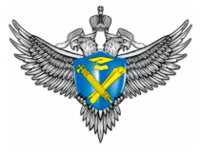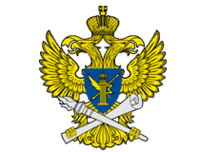Разработка урока английского языка в 7 классе по теме «Место, где я живу» с элементами подготовки к ВПР
Автор: Пономарева Виктория Михайловна
Организация: МБОУ г. Иркутска СОШ с УИОП №14
Населенный пункт: Иркутская область, г. Иркутск
Автор: Блохина Нина Иннокентьевна
Организация: МБОУ г. Иркутска СОШ с УИОП №14
Населенный пункт: Иркутская область, г. Иркутск
Согласно требованиям ФГОС России в качестве контроля обученности учащихся ежегодно в ОО проводятся Всесоюзные проверочные работы (ВПР) по учебным предметам, в том числе и по английскому языку. Особенностью заданий ВПР является их специфический характер, а именно: форма, содержание, объем.
Работая в параллели седьмых классов, мы испытывали трудности в недостатке учебного материала для подготовки к ВПР. В связи с этим, мы были вынуждены делать собственные разработки уроков с элементами заданий ВПР.
В данной статье мы представляем одну из таких разработок. На наш взгляд, большим преимуществом этой разработки является наличие в ней страноведческой информации о нашем родном крае, так как в "Программе развития и воспитания учащихся" нашей школы основной акцент делается на формирование уважительного отношения к своей Малой Родине, постоянного желания познавать ее.
Разработка урока английского языка с элементами подготовки к ВПР
в 7 классе
Тема: The place I live in. «Место, где я живу».
План урока
Цель: Актуализация знаний по теме «Место, где я живу»
Задачи:
Образовательные:
- расширить знания по теме «The place I live in»;
- активизировать лексические и грамматические навыки по данной теме;
- расширить лингвистический и страноведческий кругозор учащихся;
Развивающие:
- создать условия для развития таких аналитических способностей учащихся, как умение анализировать, сопоставлять, делать выводы;
- создать условия для развития памяти, внимания, воображения;
- содействовать формированию самостоятельной познавательной деятельности;
- содействовать развитию умений осуществлять рефлексивную деятельность;
Воспитательные:
- содействовать формированию патриотических чувств;
- содействовать развитию интереса к изучению иностранного языка;
- способствовать воспитанию гражданственности и воспитанию гордости к своему родному краю;
Методы и приемы работы: индивидуальная, парная, коллективная
Оборудование: раздаточный материал, проектор
Тип урока: Комбинированный
Формирование УУД
Регулятивные УУД:
- овладение умениями смыслового чтения текстов различных стилей и жанров в соответствии с целями и задачами;
Коммуникативные УУД:
- умение осознанно строить речевое высказывание в соответствии с задачами коммуникации и составлять монологическое высказывание в устной форме;
Познавательные УУД:
- овладение логическими действиями сравнения, анализа, синтеза, обобщения и классификации по видовременным формам, установление аналогий и причинно-следственных связей;
- расширение лингвистического кругозора;
Личностные УУД:
- осознание эмоционально-ценностного отношения к содержанию изученной темы;
-проявление интереса к изучению данной темы;
- проявление уважения к своему родному краю;
- воспитание чувства гордости за свою малую родину.
|
№ эт |
Наименование этапа |
Дидактические задачи этапа |
|
1 |
Организационный |
Обеспечить комфортную обстановку для работы на уроке; психологически подготовить учащихся к общению на уроке |
|
Методы и средства обучения- Приветствие, психологический настрой |
||
|
T.-Good morning, Children. I am glad to see you. What date is it today? Who is absent? What is the weather like today? (слайд №1) |
||
|
2 |
Постановка цели и задач урока. Мотивация учебной деятельности . |
Выдвижение предположений по теме урока и прогнозирование ее содержания: прогноз по названию (по иллюстрациям, вводный вопрос) |
|
T. –Look at the pictures. What do you see? (Учащиеся называют по-английски названия). What are we going to tell about today? (Учащиеся высказывают свои предположения) (слайд №2) T. –Well, you are right. The topic of our lesson is «The place I live in». Every person has his own Motherland. It`s a place he has been living from his birth. Look at the screen. Choose and describe one of the pictures. |
||
|
3 |
Актуализация опыта учащихся |
Приемы повторения опорных знаний, понятий, необходимых для восприятия нового языкового материала. |
|
Учащиеся выбирают и описывают одну из картинок с опорой на образец. I’d like to describe picture № …. The picture shows…. The photo was (probably) taken…. In this picture the action is taking place…. Looking at this picture I get the impression that … I like the picture because the atmosphere is …. It makes me think of …. (слайд №3) |
||
|
4 |
Первичное усвоение новых знаний |
Обеспечить восприятие, осмысление и первичное запоминание учащимися изучаемого материала. |
|
T. Today we are going to learn more about our city and region we live in. The algorithm:
Now I `ll explain how to do this task. Let's read the headings, underline the key-words and write down their synonyms.
Look in your handouts and read the texts. Choose the right heading to the texts. One heading is extra. Учащиеся подбирают заголовки к текстам, действуя по алгоритму. |
||
|
5 |
Первичная проверка понимания. |
Выполнение упражнений по образцу, применение грамматических правил при написании слов, предложений |
|
Совместная проверка выполненного задания с объяснениями. |
||
|
6 |
Закрепление новых знаний и способов деят-ти |
Обеспечить закрепление учащимися знаний и способов действий, необходимых для СР с учетом индивидуальных способов закрепления знаний, использование нового содержания совместно с ранее изученным в условиях фронтального опроса, беседы |
|
T. Look at the screen. Do you recognize these places? What are they? Will you say a few words about them? (Слайд №4) Учащиеся узнают и называют знакомые места и достопримечательности Иркутска на фото. T. The next task is read the text and fill in the appropriate word. Приступают к выполнению лексико-грамматического задания (Приложение 2) Учащиеся индивидуально выполняют данное задание. Затем работают в парах, осуществляя взаимоконтроль. T. Thank you. Well done! And now let`s talk about the architecture of Irkutsk. You should read the text and do the task. Учащиеся индивидуально выполняют третье задание, вставляя пропущенные слова (Приложение 3) . Затем учитель осуществляет проверку выполненного задания.
|
||
|
7 |
Контроль усвоения, обсуждение допущенных ошибок и их коррекция |
Обеспечить усвоение учащимися знаний и способов деят-ти на уровне их применения в различных ситуациях. Умение учащихся самостоятельно находить и исправлять ошибки. |
|
T. Well done! I hope today you have learnt more about our city and may be you will have a trip around it. To sum up, look at the screen and answer the questions: (Слайд №5 )
1. Where is Irkutsk region situated? 2. What is the important attraction of our area? 3. What is the population of the region? 4. When was it founded? Учащиеся устно отвечают на вопросы учителя, опираясь на текст.
T. Thank you. Well done! Now, please, complete the sentences(Слайд №6)
|
||
|
8 |
Информация о д/задании |
Обеспечить понимание учащимися цели, содержания и способов выполнения д/задания |
|
T. At home you should choose and describe one of the most popular places of Irkutsk. |
||
|
9 |
Подведение итогов урока |
Дать качественную оценку работы класса и отдельных учащихся |
|
Комментирование оценок, работ отдельных учащихся |
||
|
10 |
Рефлексия |
Инициировать рефлексию учащихся по поводу своей деят-ти, обеспечить усвоение принципов саморегуляции |
|
Синквейн. T. Look at the screen. (Слайд №7) Do the task. Алгоритм составления синквейна.
Example.
5. Malaya Motherland
Учащиеся составляют свои синквейны, зачитывают в классе.
T. Dear friends, the lesson is over. Thank you for your active part. Good bye. (Слайд №8)
|
||
Приложение 1
Установите соответствия между текстами и их темами, выбрав одну из списка. Используйте каждую тему только один раз. В задании одна тема лишняя.
- The historical museum
- The city of students
- The coat of arms
- The industrial center
- Climate
- Well-known corporation
- Geography
- Until the early 1990s, Irkutsk remained one of the largest industrial centers of the Russian Soviet Federative Socialist Republic with high-tech mechanical engineering: aircraft manufacturing, instrument making, radio electronics; as well as the production of metallurgical and mining equipment, automotive parts, and machine tools. Other major industries were the production of building materials, furniture, printing, light, and food industries. The five largest factories of the city employed over 40 thousand people.
- The climate of Irkutsk is sharply continental with significant daily and annual fluctuations in air temperature. Winter is cold, long and lasts more than 5 months (from late October to early April). The coldest month of the year is January, the average temperature is minus 17.8 degrees Celsius. Summer in the first half is hot and dry, in the second half there are heavy rains. The warmest month is July, the average temperature is plus 18.3 degrees Celsius.
- The leading industrial enterprise of the city is the Irkutsk Aviation Plant, which gave the name to the current Russian aircraft manufacturing corporation “Irkut”. The plant produces military and civil aircraft and employs about 12 thousand people. Irkutsk Heavy Engineering Plant manufactures gold mining, mining and processing, and metallurgical equipment.
- Irkutsk is one of the largest scientific and educational centers of Siberia. The city has a branch of the Siberian Department of the Russian Academy of Sciences with a network of scientific institutes and a number of universities, in which about 100 thousand students study.
- “Babr” is the Turkic name for a jaguar or panther; the Yakuts gave this name to the Ussuri tiger. For several centuries, the image of this beast is depicted on the coat of arms of Irkutsk, it is one of the symbols of the city. In 2012, at the entrance to the 130th quarter, a bronze sculpture of a babr 3.5 meters high and 4 meters long was installed.
- “Taltsy” — an architectural and ethnographic complex located about 40 km from Irkutsk. Here you can see a collection of monuments of the 17th-20th centuries, mostly wooden buildings from villages and towns of the region flooded during the construction of the Irkutsk Hydroelectric Station.
Приложение 2
Прочитайте текст и вставьте вместо каждого пропуска нужную грамматическую форму, выбрав ее из списка.
Irkutsk is the capital of the Eastern Siberia. The date of the foundation is marked in the report of Cossack Yaakov Pokhabov as 6th July 1661.
It is (location, located, locate) on the banks of the Angara and the Irkut rivers in 68 km away from sacred Lake Baikal. The name of the city was given by the Irkut. It is translated from the languages of local population of Siberia and Mongolia as — speedy (in, with, behind) fast flowing. Irkutsk is situated nearly in the center of Asia, probably for this very reason it is respectfully called the middle of the Earth.
In 2021 the city was celebrated the 360 anniversary. It was a big (celebrate, celebration, celebrated) for people. By the way about 600000 people live in our city according to the recent census. It makes Irkutsk one of the (large, largest, larger) cities in the Eastern part of Russia. Here one can meet representatives of more than 100 nationalities.
Our city is a big (educational, education, educate) center. The total number of students here is around 80000 that makes 12% of the city`s population. For(these, this, those) reason the average age of the inhabitants is 32 years, and state higher educational establishments train specialists almost in every field like: medicine, law, management, engineering, pedagogics, languages. There (is, were, are)30 secondary professional educational facilities, 80 secondary schools in Irkutsk.
Приложение 3
Прочитайте текст и вставьте вместо каждого пропуска подходящее слово, выбрав его из списка. Два слова в списке лишние.
Irkutsk is famous for its very … architecture. There are a lot of buildings … belong to different epochs and styles. In Irkutsk you can find buildings of Siberian Baroque; you can see Gothic and Asian motifs. Irkutsk has preserved its unique … character which many Siberian cities have lost. Irkutsk was mostly … of wood. So in the center of the city you can see a lot of very nice … buildings, for example the Estate of Sukachev, the museum of the Decembrists, but also you can see houses that are falling apart with age, it spoils all the picture of the city.
( historical , built, wood, interesting, which, located , who)

 БЕСПЛАТНЫЕ семинары
БЕСПЛАТНЫЕ семинары